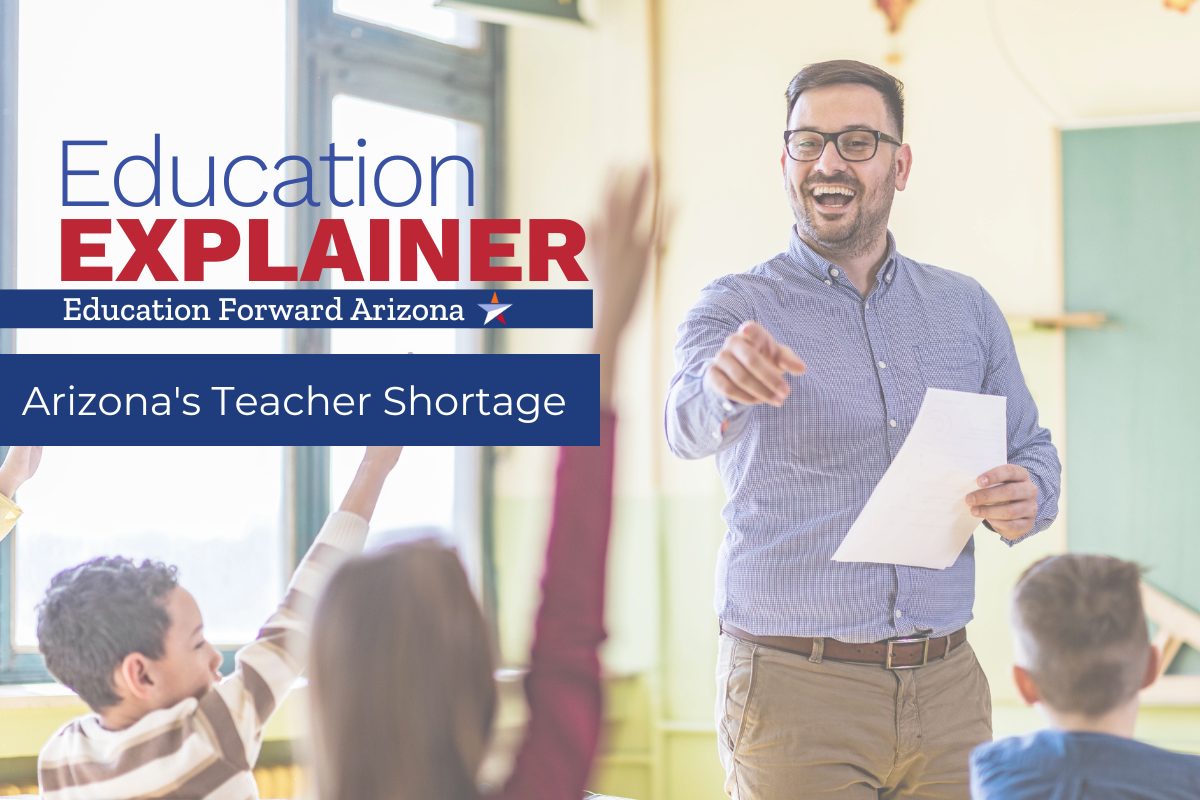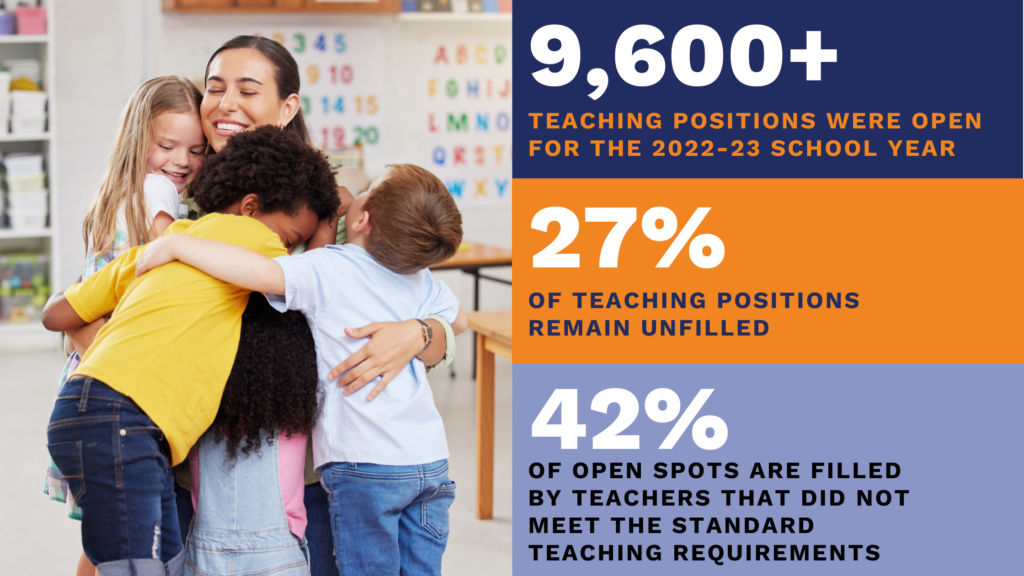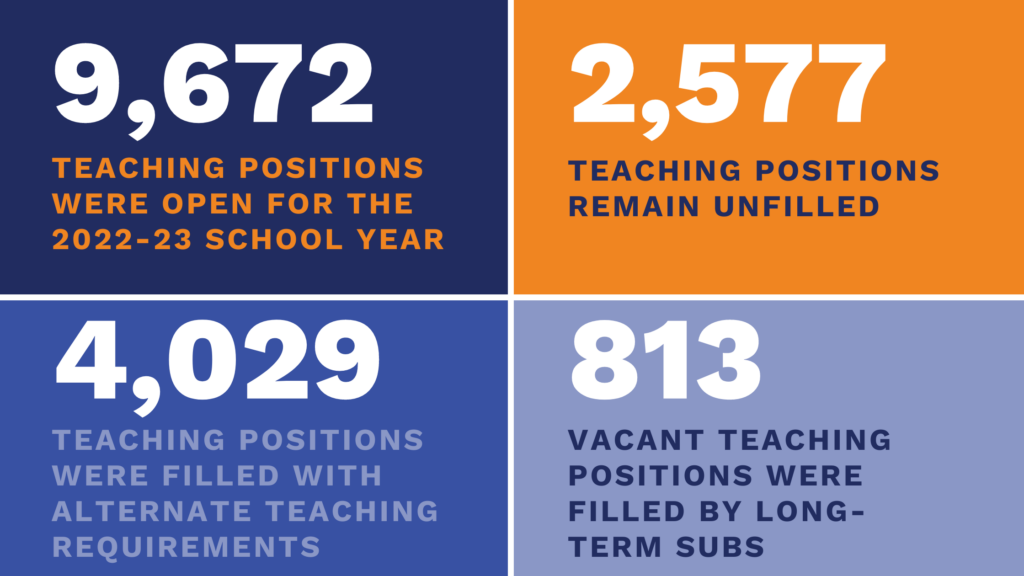
Education Explainer: Arizona’s Teacher Shortage
Arizona’s teachers are the foundation of our education system. Our teachers are the most important factor in our schools that influence student achievement. But for the last seven years, Arizona has been struggling with a teacher shortage. Recent data from the Arizona Personnel Administrators Association (ASPAA) shows that Arizona’s teacher shortage continues and is worsening.
There were over 9,600 teaching positions open for the 2022-23 school year. After one month into the school year, ASPAA showed that almost one-third (27%) of teaching positions remain unfilled. Of the teaching positions that were filled, 42% of them were filled using alternative methods by teachers that did not meet the standard teaching requirements. (Source: ASPAA)

This school year has been the hardest year affected by the pandemic.
This year, we’ve seen the biggest impact of the teacher shortage with the highest number of job openings (9,672), teaching positions unfilled (2,577), positions filled with alternate teaching requirements (4,029) and the number of vacancies filled by long-term subs (813). Each of these are the highest reported since this data has been collected. (Source: ASPAA)

The teacher recruitment and retention crisis is real. How is it impacting Arizona schools?
This summer, we convened separate groups of educators and students from across the state to talk about teacher recruitment and retention and how the state can improve student outcomes. We’ve included some of their responses throughout this blog post to share their first-hand experiences.
“One of the most important issues right now is having a quality teacher in every classroom. There’s definitely a teacher shortage. Not everyone can step into a classroom and be a teacher. Handing out teacher certification and saying because you have a degree in something means you are a teacher – it does not. In the 10 years I’ve been in the district that I’m in right now, it’s a deficit for our students.”
– Jaime, Arizona teacher
When teacher positions are left unfilled, schools use a number of strategies, including:
- Asking existing teachers to give up their planning periods to take on another class
- Divvying up students across other classes
- Using long-term substitutes
- Asking district level staff or classified staff to teach
- Recruiting international teachers
- Asking individuals who are working to earn their teaching credentials to teach
- Recruiting subject matter experts who may know an issue well, but who may not have expertise in how to teach
- Using emergency substitutes as teachers
Many of these strategies might meet the short-term need of putting a caring adult in front of a classroom, but they have other effects. For example, some of these strategies increase the workload of existing teachers, increase class sizes, or lower the quality of the instruction that students receive.
“When it comes to subs…we can never get subs so we have to split up classes. Sometimes I’ll get 5 students for a week and the kids are learning nothing because they are coming from a different grade level. The sub situation is very bad.”
– Mary, Arizona teacher
When people enter the teaching profession using alternative methods, superintendents tell us anecdotally that keeping them long-term is even more difficult, because they don’t have the full training and preparation to be a teacher. Schools also have to compensate to provide additional training and support for these teachers with alternative qualifications, often taking away resources originally planned for other purposes.
How is the teacher shortage impacting students?
For students, it might mean larger class sizes, gaps in learning, or having less-qualified adults who are leading their classrooms who don’t have the expertise to manage a classroom or teach the content required.
“I had three or four subs for AP government. At first it was, ‘he was gone for a week,’ but then he decided to retire. We got another teacher who lasted a few days but during that time we were doing packets – that wasn’t really learning. Then another person came and we were doing virtual activities where we would watch a video and do an activity for three or four months. Then we had a fourth teacher who was very strict but not very welcoming. That led to me teaching a lot of content myself.”
– Odalis, Recent Arizona High School Graduate
What’s the impact on our teachers?
Our teachers are burned out and are leaving the profession. As we’ve talked with teachers over the summer, the biggest issue they’ve raised is with teacher working conditions. Working conditions are the things that surround their positions, including things like: workload, class sizes, time for planning and collaboration with their peers, do they have opportunities to grow and be mentored, are they supported when they are new in their position, do they have the resources they need to do their jobs, how teachers are valued by the community, support from parents and families, and more. Pay is certainly an important consideration, but is often not at the top of the list of reasons why teachers leave. But at some point, the idealism that many teachers have to make a difference is outweighed by the stress and burnout felt from worsening working conditions.
“As an English teacher, my largest class last year was 38. Multiply that by 5 for a total of 175 or 180 students that I teach. When you are loading up core teachers and giving them that many students in a classroom, it is really unhealthy for students and educators.”
-Rachel, Arizona teacher
“Protect the time given to teachers for planning. Right now, this time is taken up by subbing in other classes because those classes don’t have teachers or substitutes. Last year, it was probably three times a week that I was been asked to give up my planning time.”
– Paula, Arizona teacher
“Overall it’s the stigma of how teachers are valued. If we were treated as professionals we could deal with the pay and other issues. We knew going into the profession that it wasn’t going to be the best pay in the world. But the stigma that teachers aren’t doing their jobs or working hard…we need to change how teachers are valued in our society.”
– Angela, Arizona teacher
“There are plenty of people who could be great teachers, but they pursue other professions that pay better. People are turned off from teaching because of how low the pay is. If teacher pay was higher and more competitive with other professions then maybe more people who could be great teachers would be teachers.”
– Mary, Arizona teacher
So what do we do?
As a state, we’ve taken some measures to increase the incoming pipeline of new teachers. For example, the Arizona Teachers Academy is a loan-forgiveness program for future teachers at ASU, UA, NAU, Scottsdale Community College, Pima Community College, and Rio Salado college. The program is growing and is offering future teachers to have their college loans forgiven if they teach in Arizona schools. Also, just off the ground is the Arizona Teacher Residency program, out of the K-12 Center at NAU and soon to be launched are bachelor’s degrees offered by community colleges, some which will be in education fields. Additionally, the federal COVID relief funding allowed some districts to give bonuses to or to hire additional support staff. It also allowed for meaningful, short-term investments to be made by ADE in mentoring, professional development, and filling teacher gaps in rural schools, among other projects. The 20% by 2020 teacher pay raise was helpful in providing direct resources to increase pay, as was the increase to base level funding this year.
But what’s missing is a concentrated effort to improve working conditions and raise teacher pay to the national median over the long-term. What’s also missing is a focus on ensuring that we are fully preparing and supporting new teachers, which could improve both student achievement and teacher retention. Lowering the bar to get more people in front of classrooms might meet a short-term need, but doesn’t pay off in the long-run.
Teacher recruitment and retention is one of the most important issues facing our education system that deserves our immediate attention.
As a state, we have an opportunity with new elected officials to elevate teacher recruitment and retention as a top priority in this coming legislative session. To hear more about how the candidates for Governor and Superintendent of Public Instruction plan to address the teacher shortage, visit EdVotersArizona.org.
